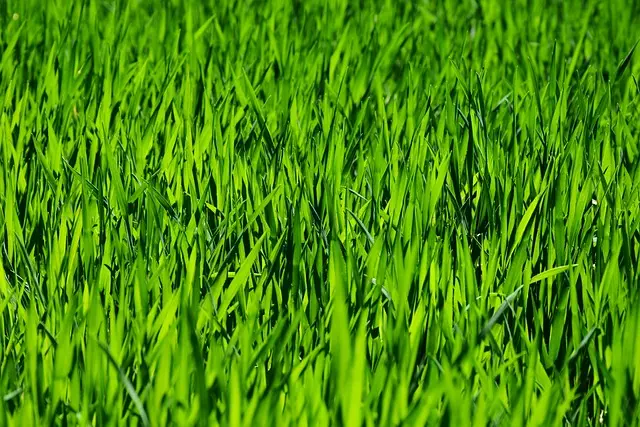A robust lawn care and landscaping regimen is essential for maintaining a healthy, vibrant green space. This involves regular mowing at an optimal height for your grass type, encouraging root growth, and naturally deterring weeds. Fertilization should be tailored to the specific nutrient needs of your soil and turf, considering local climate conditions and timing for best results. Aeration annually helps prevent compaction and ensures that water, air, and nutrients can effectively reach the roots. Managing thatch is also important to prevent it from harming lawn health. Integrated pest management, which includes biological controls or environmentally friendly chemicals when necessary, should be employed to protect your lawn from pests. Proper irrigation using advanced smart systems is key for conserving water and maintaining consistent moisture levels without waste. Additionally, a thorough soil composition analysis will guide you in achieving a balanced soil that supports grass root absorption of nutrients and moisture. Utilizing both organic and inorganic fertilizers, as well as adhering to the correct mowing height and performing aeration, are all practices that contribute to a lush, sustainable landscape that embodies the best in lawn care and landscaping. Smart irrigation systems further enhance these efforts by delivering precise water amounts based on soil moisture and local weather, promoting plant health while conserving water, aligning with sustainable landscaping principles, and demonstrating environmental stewardship.
Embark on a journey to transform your outdoor space into a lush oasis with our comprehensive guide on Garden Maintenance and Beautification. Discover the art of lawn care through Essential Practices for Vibrant Lawn Care, where we delve into understanding soil composition, optimizing irrigation systems, and controlling weeds and pests organically. Learn mowing techniques for a lush, dense lawn and breathe new life into your turf with aerating and overseeding. Next, unlock the secrets of Creative Landscaping Ideas to Enhance Your Outdoor Space, featuring design principles that ensure a balanced and harmonious garden layout, and explore the beauty of seasonal plants for an ever-changing tapestry of color and texture. Add tranquility and biodiversity with water features or opt for xeriscaping to conserve water while maintaining a stunning landscape. Utilize raised beds and containers for flexible planting options that cater to both aesthetics and function. Finally, tailor your Seasonal Garden Maintenance for Year-Round Appeal with tailored advice for every season, from spring revival to winter care, ensuring your garden thrives 365 days a year. Dive into the world of Lawn Care and Landscaping to create a space that’s both beautiful and sustainable.
- Essential Practices for Vibrant Lawn Care
- – Understanding Soil Composition and Fertilization Needs
- – Effective Irrigation Systems for Optimal Hydration
Essential Practices for Vibrant Lawn Care

Engaging in regular lawn care and landscaping practices is key to nurturing a vibrant and healthy lawn. A robust maintenance schedule should include consistent mowing at the correct height for your grass type, which typically stands between one-third and one-half of the grass blade’s length. This not only promotes a neat appearance but also encourages root growth and helps prevent weeds from taking over. Regularly fertilizing your lawn with balanced nutrients is another fundamental aspect of lawn care, as it replenishes the soil and supports the growth of your grass. The type and timing of fertilization can vary depending on local climate conditions and the species of your turf, so it’s important to tailor this to your specific environment.
In addition to regular mowing and fertilization, effective lawn care involves managing thatch buildup, controlling pests, and overseeing the health of the soil. Aerating your lawn at least once a year can alleviate soil compaction, allowing air, water, and nutrients to penetrate the roots more effectively. This practice also assists in reducing the amount of thatch present, which is an accumulation of dead grass and roots that, if left unchecked, can hinder lawn health. Furthermore, identifying and treating pests early on is crucial to maintaining a lush, green lawn. Utilizing integrated pest management (IPM) strategies, such as biological controls or eco-friendly chemicals when necessary, can help manage pests while minimizing environmental impact. Lastly, ensuring proper irrigation practices to conserve water and keep your lawn evenly moist is essential for a thriving landscape. By integrating these essential practices into your lawn care routine, you’ll be well on your way to achieving a vibrant and beautiful yard that stands as a testament to your dedication to landscaping excellence.
– Understanding Soil Composition and Fertilization Needs

Engaging in a thorough understanding of soil composition is pivotal for effective lawn care and landscaping practices. Soil analysis can reveal its texture, structure, nutrient content, and drainage properties, all of which influence plant growth and health. A balanced soil composition ensures that roots can efficiently absorb essential nutrients and water. To maintain this balance, it’s crucial to select the right fertilizer for your lawn type and local climate. Organic options, such as compost and manure, enrich the soil naturally while supporting a healthy microbial ecosystem. Inorganic fertilizers, on the other hand, provide quick-release nutrients that can be tailored to address specific deficiencies in your soil. Understanding the timing of applications, the type of grass species present, and the seasonal variations in growth patterns will enhance the overall vitality of your lawn. Regular maintenance, including proper mowing height and aeration practices, complements fertilization efforts by promoting a robust root system and preventing thatch buildup, thus contributing to a lush, green landscape that is both aesthetically pleasing and environmentally sound.
– Effective Irrigation Systems for Optimal Hydration

Effective lawn care and landscaping involve a well-designed irrigation system to ensure optimal hydration for your garden. Traditional sprinkler systems have evolved into smart irrigation solutions that conserve water while providing uniform moisture to your plants. These systems use weather sensors to adjust watering schedules according to the soil’s moisture levels and local weather forecasts, thus preventing overwatering or underwatering. The precision of these systems not only conserves water but also promotes healthier plant growth by delivering water directly where it is needed most. For gardens with varying terrain or specific plant requirements, drip irrigation might be the preferred choice. This method delivers water slowly and directly to the roots of plants, minimizing evaporation and runoff. It’s a cost-effective solution that can be tailored to individual plant needs, ensuring that each area of your lawn or garden receives the precise amount of hydration necessary for lush, vibrant landscapes all year round. Landscaping with an eye on sustainable practices and integrating efficient irrigation systems is key to maintaining a beautiful outdoor space while respecting the environment.
In conclusion, maintaining a lush and vibrant garden requires consistent effort and knowledge of optimal lawn care practices. By understanding soil composition and fertilization needs, homeowners can cultivate a healthy lawn. Similarly, the implementation of effective irrigation systems ensures that plants receive the hydration they need to thrive. Landscaping efforts extend beyond these technical aspects; they also involve an artistic touch, allowing individuals to personalize their outdoor spaces into beautiful retreats. Embracing these landscaping and lawn care strategies not only enhances the aesthetic appeal of your property but also supports a sustainable environment.
